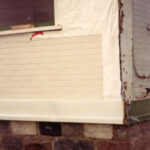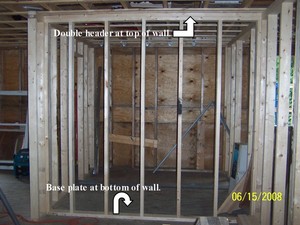Wood is a common siding because it can be used in several different applications, it’s pretty easy to install and it’s relatively inexpensive. T1-11 siding, as it’s commonly called, is a good exterior siding and it can be applied directly over the studs. T1-11 has grooves for decoration and you can choose between 4 inch grooved spacing or 8 inch spacing. You can also get what is called a reverse board and batten that is 12 inch on center. For siding a wall with 16 inch on on center studs you need to use 3/8 inch plywood and for those walls with studs spaced 24 inch on center, you need to use 1/2 inch plywood. Joints need to meet at a stud for support and for a nailing surface for the plywood. Trim is also important because the exposed edges will be vulnerable to weather and trim will protect them.
The first thing you need to do is create a guide for the bottom edges of the siding. Do this with a line level and chalk line. Level the chalk line with a line level, then remove the level and snap the line on all four sides of the shed. Before I go any further, I will tell you that it’s a good idea to have a helper when putting up siding, a 4×8 sheet of plywood may not sound very big but it is, they are heavy and awkward. With a helper, hold the first panel at a corner and align the bottom edges with the chalk line. Make sure that the panel is plumb and the edges are centered on studs, you may need to trim a little to get the edges right. With the panel in place you need to mark the top so you can cut it at the rafters. Once you have the panel marked take it down and cut the openings in its top edge for the rafters. Make the openings 1/8 inch larger than the rafters so they’ll fit without a tight squeeze.
Nail the first panel in place with galvanized nails so they won’t stain in the wood. Drive nails 6 inches apart around the panel edges and 12 inches apart into the remaining studs. For plywood up to 1/2 inch thick, use 6d (2 inch) nails. If you are using thicker panels use nails that penetrate at least 1-1/2 inches. Cut rafter openings in the second panel and nail it alongside the first, leaving a 1/8″ gap between them for swelling, and continue with this process all the way around.
When you get to an opening such as a window, measure the window and cut pieces to fit around it. You need to allow for a 3/8 inch gap around the window for caulking. Once you have the outline of the opening cut it out with a circular saw or a saber saw. Using a saber saw, cut small panels to cover the rake (the space created by the pitched roof). To make the connection between the two sections use horizontal Z flashing. To finish the top between the rafters cut 1x lumber to fit between the rafters and over the siding. Nail this trim up with 4d (1-1/2 inch) nails. Trim the corners with 1x lumber as well, butt 1×4 and a 1×3 together at each corner and nail them to the shed and to each other using 4d nails. Next you need to caulk the gaps around windows, doors, and corners. You should also apply a little caulking in the gaps between the panels themselves.
Putting up plywood siding is pretty easy if you have some help. With accurate measurements and a good saw you should be able to move right along with installing siding. The more difficult part of this job is the finishing, which includes putting up trim and creating a clean finished look. The last part of putting up siding is either treating it or painting it. Use a high quality outdoor paint or stain to ensure that it will look great for years to come. The first paint job on siding will always last the longest so use a good product. This is how you apply plywood siding, good luck.



